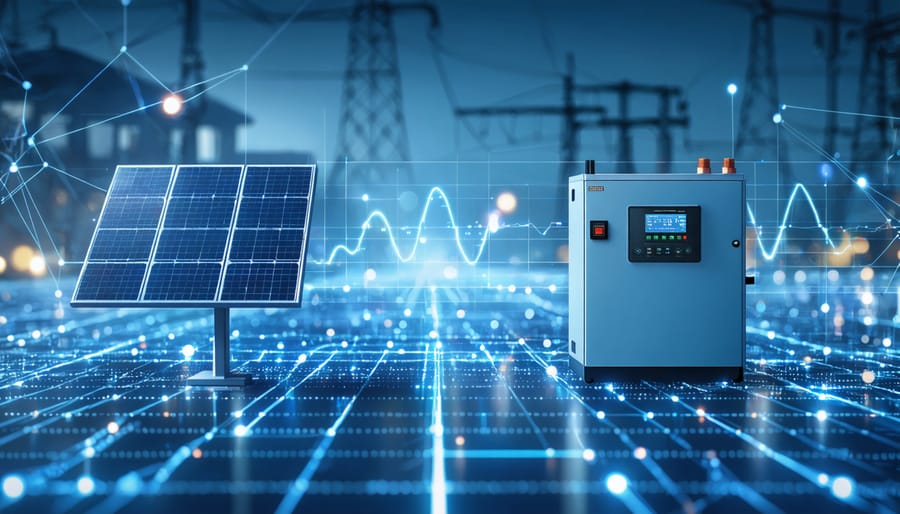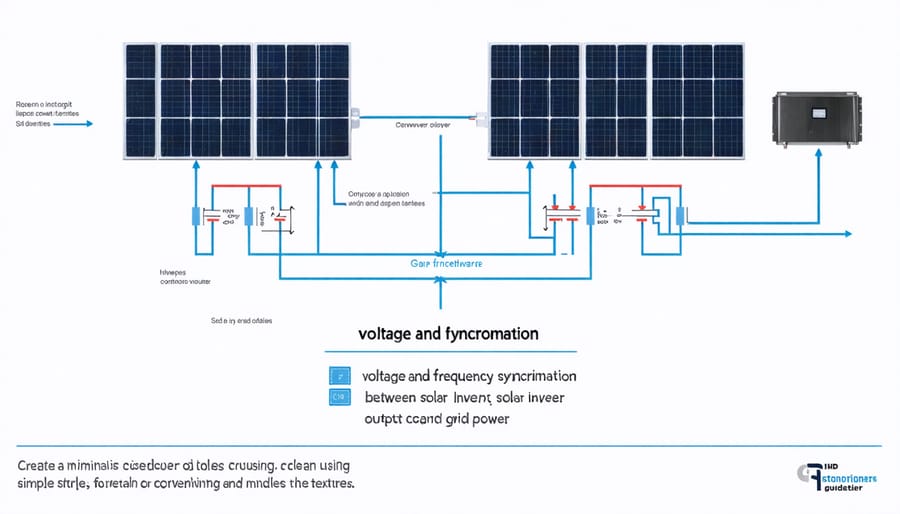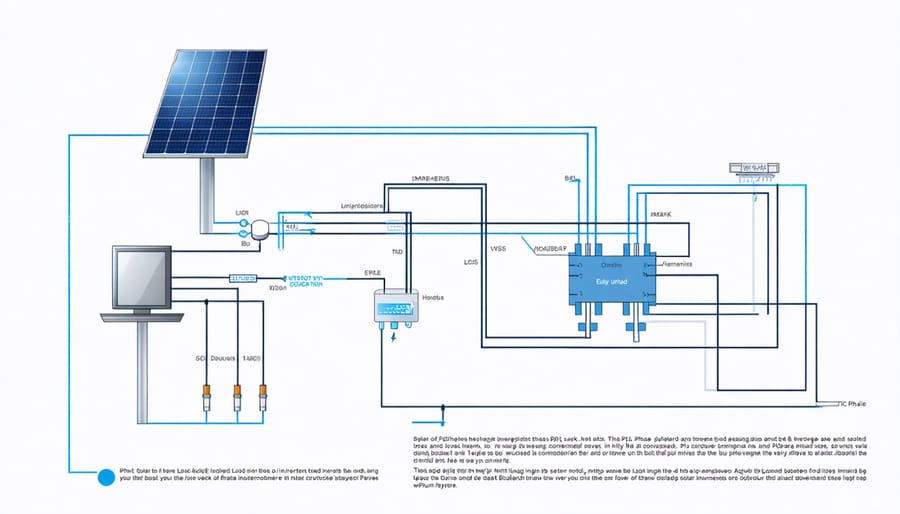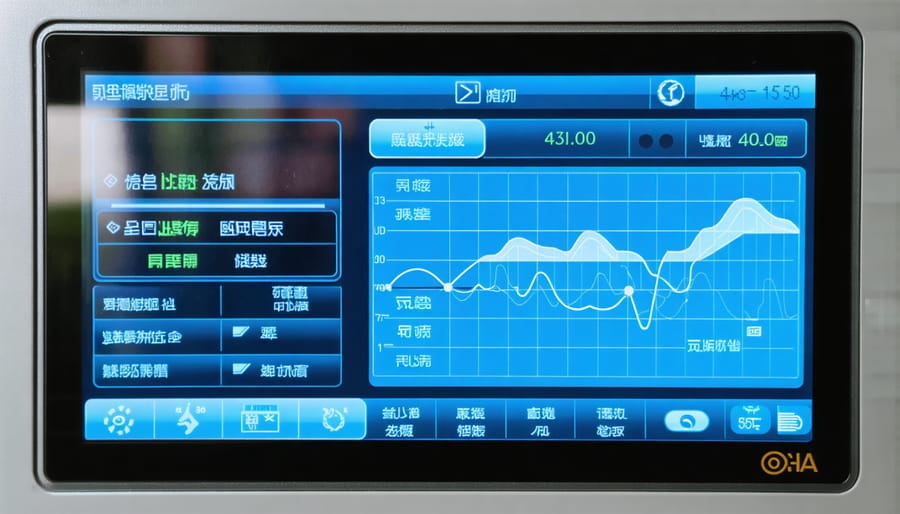Solar Inverter Grid Synchronization: Making Your System Work Seamlessly with the Power Grid

Grid synchronization stands at the heart of modern solar power systems, where solar inverters perform an intricate dance of matching frequency, voltage, and phase with the utility grid. This critical process ensures seamless power flow between your solar installation and the broader electrical network, making it possible to both consume and export clean energy efficiently.
Much like a conductor coordinating an orchestra, the inverter’s synchronization mechanism continuously monitors grid parameters through sophisticated electronic controls, adjusting its output in milliseconds to maintain perfect harmony. This precise coordination not only protects your electrical equipment but also ensures compliance with European grid codes and safety standards.
As renewable energy reshapes Europe’s power landscape, understanding grid synchronization becomes increasingly vital for homeowners and businesses investing in solar technology. Modern inverters employ advanced digital signal processors and phase-locked loop systems to maintain this delicate balance, representing a remarkable fusion of power electronics and smart technology that makes sustainable energy integration possible.
This technical achievement, often operating silently in the background, forms the foundation of reliable solar power integration across the continent, enabling millions of installations to contribute to a more sustainable energy future.
The Fundamentals of Grid Synchronization
Key Parameters for Grid Synchronization
For successful grid synchronization, solar inverters must precisely match three critical parameters with the utility grid. First, the voltage output must align exactly with the grid voltage, typically 230V in European residential systems or 400V in three-phase installations. Even minor voltage mismatches can result in efficiency losses or system shutdowns.
Frequency synchronization is equally crucial, with European grid standards requiring exact matching to 50Hz. Modern inverters employ sophisticated frequency tracking systems that can respond to micro-variations within milliseconds, ensuring stable power flow.
The phase matching requirements are perhaps the most demanding, particularly in three-phase systems. The inverter must align its output waveform perfectly with the grid’s sine wave, maintaining a phase angle difference of less than ±1 degree. This precise synchronization prevents destructive interference and ensures optimal power transfer.
Advanced monitoring systems continuously verify these parameters, automatically disconnecting the inverter if any values drift outside acceptable ranges, thus protecting both the solar installation and the grid infrastructure.

European Grid Standards and Requirements
In Europe, solar inverter grid synchronization must comply with strict standards set by the European Network of Transmission System Operators for Electricity (ENTSO-E). The key regulation governing grid connection is EN 50549, which establishes essential requirements for power generating systems up to 1000V AC.
European inverters must demonstrate precise frequency control (50Hz ±0.5Hz) and voltage regulation capabilities. The VDE-AR-N 4105 standard, particularly relevant in Germany, requires inverters to maintain power quality within specific parameters and respond to grid fluctuations appropriately.
Modern European grid codes mandate that inverters include anti-islanding protection, low voltage ride-through (LVRT) capabilities, and reactive power control. These features ensure grid stability and safety during various network conditions. Additionally, inverters must carry CE marking and comply with electromagnetic compatibility (EMC) standards EN 61000-6-1 and EN 61000-6-3.
Installation requirements vary by country, but most European nations require professional certification for installers and regular system inspections to maintain compliance with these standards. This ensures optimal performance and grid stability across the continent’s interconnected power networks.
How Solar Inverters Achieve Grid Synchronization
Phase-Locked Loop Technology
Phase-Locked Loop (PLL) technology serves as the heart of grid synchronization in modern solar inverters. This sophisticated control system continuously monitors and adjusts the inverter’s output to match the grid’s voltage, frequency, and phase angle with remarkable precision.
At its core, a PLL system works by comparing the grid’s electrical parameters with the inverter’s output signals. When it detects any discrepancy, it automatically generates correction signals to align the inverter’s output perfectly with the grid. This process happens thousands of times per second, ensuring seamless integration of solar power into the utility network.
The PLL mechanism employs advanced digital processing techniques to maintain stability even during grid disturbances. Modern inverters use enhanced PLL algorithms that can handle various grid conditions common in European networks, including voltage fluctuations and frequency variations within the limits specified by local grid codes.
What makes PLL technology particularly valuable is its ability to respond rapidly to changes while maintaining stable operation. This quick response helps protect both the solar installation and the grid infrastructure, contributing to the overall reliability of renewable energy systems.
For homeowners and businesses, this means their solar systems can operate efficiently and safely while complying with all relevant European grid connection requirements. The technology works silently in the background, ensuring optimal power quality and maximum energy yield from your solar investment.

Voltage and Frequency Monitoring
One of the most critical functions of a modern solar inverter is its ability to continuously monitor and match the grid’s voltage and frequency parameters. European grid standards typically require a voltage of 230V (±10%) and a frequency of 50Hz (±0.5Hz), and inverters must maintain these parameters precisely for safe and efficient power distribution.
Advanced monitoring systems within the inverter use sophisticated sensors to measure grid voltage and frequency in real-time. These measurements occur thousands of times per second, ensuring immediate response to any fluctuations. The inverter’s control system processes this data and adjusts its output accordingly, maintaining perfect synchronization with the grid.
When converting DC power from solar panels to AC power, the inverter generates a pure sine wave that matches the grid’s characteristics exactly. This process involves careful regulation of both amplitude (voltage) and timing (frequency) to ensure the power flows smoothly into the grid without causing disturbances or safety issues.
If the grid parameters deviate beyond acceptable limits, the inverter’s protective mechanisms activate automatically. Modern inverters in European installations feature anti-islanding protection, which disconnects the system from the grid during power outages or significant variations in voltage or frequency, ensuring safety and grid stability.
These monitoring and control capabilities make solar inverters essential components in maintaining grid stability while maximizing renewable energy integration across Europe’s power networks.
Safety and Protection Mechanisms
Modern solar inverters incorporate sophisticated safety mechanisms to protect both the equipment and the power grid. At the heart of these protections is anti-islanding technology, which ensures the inverter automatically disconnects from the grid during power outages. This crucial feature prevents dangerous feedback of electricity into the grid, protecting utility workers during maintenance operations.
European standards require inverters to maintain strict voltage and frequency tolerances. If grid parameters deviate beyond acceptable ranges, the inverter’s protective relays trigger an immediate shutdown. This monitoring happens continuously, with response times typically under 200 milliseconds, ensuring optimal safety and grid stability.
Additional safety features include ground fault protection, surge protection, and DC reverse polarity protection. These mechanisms safeguard against electrical faults, lightning strikes, and incorrect wiring during installation. Many modern inverters also feature integrated arc fault detection, which can prevent potential fire hazards by identifying and responding to dangerous electrical arcs.
Remote monitoring capabilities enhance safety by allowing system operators to detect and respond to abnormalities promptly. Smart diagnostic systems continuously analyse performance parameters, triggering alerts when potential issues arise. This proactive approach to safety ensures compliance with European grid codes while maximising system reliability and longevity.
For enhanced grid stability, inverters implement power quality protection features that monitor harmonic distortion and power factor, automatically adjusting output to maintain optimal grid conditions.
Smart Grid Integration Features

Dynamic Power Control
Modern solar inverters employ sophisticated mechanisms to continuously adjust their power output based on grid conditions. This dynamic control system ensures optimal performance while maintaining grid stability, a crucial requirement for European power networks.
The inverter’s microprocessor monitors real-time grid parameters, including voltage, frequency, and power demand. When grid voltage fluctuates, the inverter automatically adjusts its power output to prevent over-voltage situations during peak solar production or under-voltage scenarios during high demand periods.
Maximum Power Point Tracking (MPPT) algorithms work in conjunction with grid synchronization to optimize power generation. The system continuously calculates the ideal operating point, balancing maximum solar energy harvest with grid compatibility requirements.
During periods of grid instability, smart inverters can rapidly modify their output characteristics. They may reduce power generation, adjust power factor, or provide reactive power support to help stabilize the local grid network. This functionality is particularly valuable in regions with high renewable energy penetration.
European grid codes require inverters to maintain specific power quality standards. Modern inverters achieve this through advanced control features like active power curtailment and reactive power compensation, ensuring seamless integration with the utility grid while maximizing energy yield for system owners.
Grid Support Functions
Modern solar inverters offer sophisticated grid support functions that enhance overall power system stability and quality. These advanced features, mandated by European grid codes, help maintain a reliable electricity network while maximising renewable energy integration.
Key grid support capabilities include voltage regulation, where inverters can dynamically adjust their reactive power output to help stabilise grid voltage levels. During minor voltage fluctuations, inverters can provide low voltage ride-through (LVRT) support, allowing solar systems to remain connected and continue contributing to grid stability rather than disconnecting.
Frequency regulation is another crucial function, with inverters able to automatically adjust their power output in response to grid frequency changes. This helps maintain the critical 50Hz frequency standard across European power networks. Some advanced inverters also offer synthetic inertia, mimicking the stabilising effect traditionally provided by rotating generators.
Power quality enhancement features include harmonic filtering and power factor correction. These functions help reduce distortions in the grid’s electrical waveform and optimise power flow efficiency. Many modern inverters can also provide grid monitoring data to network operators, contributing to better system management and fault detection.
During grid disturbances, smart inverters can rapidly respond with fault current contribution and anti-islanding protection, ensuring both grid stability and safety. These capabilities make solar installations active contributors to grid resilience rather than passive power generators.
Troubleshooting and Maintenance
Common Synchronization Challenges
Grid synchronization can face several challenges that require careful attention and solutions. One common issue is voltage fluctuations in the grid, which can cause synchronization difficulties. Modern inverters address this through advanced voltage monitoring systems that continuously adjust output parameters to maintain stable synchronization.
Phase imbalance presents another significant challenge, particularly in three-phase systems common across Europe. Smart inverters employ sophisticated phase-tracking algorithms to ensure proper alignment, even during minor grid disturbances. This is crucial for maintaining system stability and preventing unwanted disconnections.
Frequency variations, though rare in European grids, can also impact synchronization. Quality inverters feature rapid response mechanisms that can adjust to frequency deviations within milliseconds, ensuring continuous power flow. These systems must comply with strict European grid codes and standards.
Grid harmonics and power quality issues can interfere with proper synchronization. To counter this, inverters use active filtering technology and power quality enhancement features. Regular maintenance and monitoring help identify potential synchronization issues before they become critical, ensuring optimal system performance and grid stability.
During grid faults or blackouts, inverters must quickly detect the situation and safely disconnect to prevent islanding, reconnecting only when stable grid conditions return.
Regular Maintenance Requirements
To ensure optimal performance and longevity of your grid-tied solar inverter system, regular maintenance is essential. A comprehensive maintenance schedule should include quarterly visual inspections of the inverter housing for dust, debris, or signs of wear. Clean the cooling fins and ventilation areas carefully using compressed air or a soft brush to prevent overheating.
Monitor the inverter’s display panel monthly for error codes or unusual readings, and verify that all electrical connections remain tight and corrosion-free bi-annually. The DC isolation switch should be tested every six months to confirm proper functionality.
European standards recommend professional inspection annually, particularly before and after extreme weather seasons. During these inspections, technicians should verify grid synchronization parameters, check firmware updates, and calibrate voltage and frequency settings if necessary.
Keep detailed maintenance records and respond promptly to any warning signals or performance drops. Most modern inverters feature remote monitoring capabilities, allowing for real-time performance tracking and early problem detection. This proactive approach to maintenance helps maintain optimal synchronization efficiency and extends the system’s service life.
Solar inverter grid synchronization represents a crucial cornerstone of modern renewable energy integration, combining sophisticated technology with practical reliability. Throughout this exploration, we’ve seen how inverters seamlessly match grid voltage, frequency, and phase angle while maintaining power quality and safety standards across European networks.
The evolution of grid synchronization technology continues to advance, with smart inverters increasingly incorporating AI-driven algorithms and IoT capabilities. These innovations enable more precise control, faster response times, and enhanced grid stability, particularly valuable as Europe moves towards its ambitious renewable energy targets.
For homeowners and businesses investing in solar energy systems, understanding grid synchronization ensures better system performance and compliance with local regulations. The integration of advanced monitoring systems and automated grid support features makes modern inverters more efficient and reliable than ever before.
Looking ahead, we can expect further developments in grid synchronization technology, particularly in areas such as virtual power plants and dynamic grid support services. The increasing adoption of energy storage systems will also play a vital role, enabling more sophisticated grid interaction capabilities.
As European power networks continue to evolve towards a more distributed and renewable-based structure, efficient grid synchronization will remain fundamental to achieving a sustainable energy future. The ongoing refinement of these technologies promises even greater system reliability, improved energy efficiency, and enhanced grid stability for years to come.
Leave a Reply